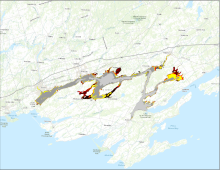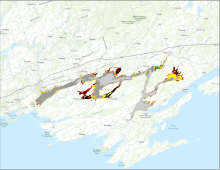Sciences
Type of resources
Topics
Keywords
Contact for the resource
Provided by
Formats
Representation types
Update frequencies
status
-
Fleming Survey of Juvenile Atlantic Cod in Coastal Avalon and Northeast Newfoundland (NAFO Div. 3KL)

The Department of Fisheries established a survey of demersal juvenile Atlantic cod (*Gadus morhua*) in the nearshore (<10 m deep) in 1959. This survey aimed to characterize the distribution and abundance of juvenile Atlantic cod and was based upon Norway's Flodevigen sampling program which has been conducted continuously since 1919. A 25 m seine was used to sample juvenile Atlantic cod nursery locations on the Avalon Peninsula and Northeast coast of the island of Newfoundland in September and October. The survey continued until 1964 and became known as the Fleming survey, after original initiator Alistair Fleming. The survey was reinstated by Memorial University of Newfoundland from 1992 to 1997. Multiple tows were conducted at a subset of the original 55 Fleming sites located in St. Mary's Bay, Trepassey Bay, the Southern Shore, Conception Bay, Trinity Bay, Bonavista Bay, Gander Bay, New World Island, Fortune Harbour, Badger Bay, Halls Bay and Green Bay. This data set includes several different subsets, some of which span both Fleming Survey periods (1959-1964 and 1992-1997): I. JuvCodCatch60s90s: Catches of juvenile Atlantic cod (1959-1964, 1992-1997) from the first two consecutive tows at each site. This is a summary based on JuvCodLengths90s and FlemingSurveyData60s; II. JuvCodLength90s: Lengths of all individual juvenile Atlantic cod caught for each site (1992-1997); III. SiteEnvData60s90s: Station data for Fleming data 1992-1997; IV. FlemingSurveyData60s: Fleming survey data from 1959-1964 (note there are three record types pertaining to: station data "type 1"; general species catch data including juvenile Atlantic cod grouped by age class ("1+", "Zeroes", and "Total") "type 2; and juvenile Atlantic cod (species 223) listed in length bins "type 3"; and V. FlemingBycatch60s92to96: Bycatch data from 1959-1964 & 1992-1996 from first two tows at each site. This is a summary based partly on the FlemingSurveyData60s set.
-

Fish Habitat Assessment Output: 2 of 16 High Water Level (75.4m ASL) - Spawning Habitat - Low Vegetation Association Species (All Temperature Windows) Habitat suitability was assessed for the Bay of Quinte Area of Concern, at a 3 m grid resolution, using the Habitat Ecosystem Assessment Tool (HEAT), temperature algorithms, vegetation models, and water level input. Habitat classifications were based on three variables: depth (elevation), vegetation, and substrate; and modified by temperature suitabilities. The final suitability maps were based on documented habitat and temperature associations for the fish in the area. Different life stages (spawning requirements, nursery habitat, adult habitat) were modeled for the years of 1972-2011. Suitability values were scaled from 0 (not suitable) to 1 (highly suitable) and converted to suitability classes of very low, low, medium, and high. The final maps for each guild – life stage combination are maximum suitability values from the 39-year period modelled.
-

Fish Habitat Assessment Output: 11 of 16 Average Water Level (75.0m ASL) - Nursery Habitat - High Vegetation Association Species (All Temperature Windows) Habitat suitability was assessed for the Bay of Quinte Area of Concern, at a 3 m grid resolution, using the Habitat Ecosystem Assessment Tool (HEAT), temperature algorithms, vegetation models, and water level input. Habitat classifications were based on three variables: depth (elevation), vegetation, and substrate; and modified by temperature suitabilities. The final suitability maps were based on documented habitat and temperature associations for the fish in the area. Different life stages (spawning requirements, nursery habitat, adult habitat) were modeled for the years of 1972-2011. Suitability values were scaled from 0 (not suitable) to 1 (highly suitable) and converted to suitability classes of very low, low, medium, and high. The final maps for each guild – life stage combination are maximum suitability values from the 39-year period modelled.
-

Fish Habitat Assessment Output: 8 of 16 High Water Level (75.4m ASL) - Juvenile/Adult Habitat - Low Vegetation Association Species (Coldwater) Habitat suitability was assessed for the Bay of Quinte Area of Concern, at a 3 m grid resolution, using the Habitat Ecosystem Assessment Tool (HEAT), temperature algorithms, vegetation models, and water level input. Habitat classifications were based on three variables: depth (elevation), vegetation, and substrate; and modified by temperature suitabilities. The final suitability maps were based on documented habitat and temperature associations for the fish in the area. Different life stages (spawning requirements, nursery habitat, adult habitat) were modeled for the years of 1972-2011. Suitability values were scaled from 0 (not suitable) to 1 (highly suitable) and converted to suitability classes of very low, low, medium, and high. The final maps for each guild – life stage combination are maximum suitability values from the 39-year period modelled.
-

Fish Habitat Assessment Output: 3 of 16 High Water Level (75.4m ASL) - Nursery Habitat - High Vegetation Association Species (All Temperature Windows) Habitat suitability was assessed for the Bay of Quinte Area of Concern, at a 3 m grid resolution, using the Habitat Ecosystem Assessment Tool (HEAT), temperature algorithms, vegetation models, and water level input. Habitat classifications were based on three variables: depth (elevation), vegetation, and substrate; and modified by temperature suitabilities. The final suitability maps were based on documented habitat and temperature associations for the fish in the area. Different life stages (spawning requirements, nursery habitat, adult habitat) were modeled for the years of 1972-2011. Suitability values were scaled from 0 (not suitable) to 1 (highly suitable) and converted to suitability classes of very low, low, medium, and high. The final maps for each guild – life stage combination are maximum suitability values from the 39-year period modelled.
-

Fish Habitat Assessment Output: 7 of 16 High Water Level (75.4m ASL) - Juvenile/Adult Habitat - Low Vegetation Association Species (Coolwater Guild) Habitat suitability was assessed for the Bay of Quinte Area of Concern, at a 3 m grid resolution, using the Habitat Ecosystem Assessment Tool (HEAT), temperature algorithms, vegetation models, and water level input. Habitat classifications were based on three variables: depth (elevation), vegetation, and substrate; and modified by temperature suitabilities. The final suitability maps were based on documented habitat and temperature associations for the fish in the area. Different life stages (spawning requirements, nursery habitat, adult habitat) were modeled for the years of 1972-2011. Suitability values were scaled from 0 (not suitable) to 1 (highly suitable) and converted to suitability classes of very low, low, medium, and high. The final maps for each guild – life stage combination are maximum suitability values from the 39-year period modelled.
-

Fish Habitat Assessment Output: 4 of 16 High Water Level (75.4m ASL) - Nursery Habitat - Low Vegetation Association Species (All Temperature Windows) Habitat suitability was assessed for the Bay of Quinte Area of Concern, at a 3 m grid resolution, using the Habitat Ecosystem Assessment Tool (HEAT), temperature algorithms, vegetation models, and water level input. Habitat classifications were based on three variables: depth (elevation), vegetation, and substrate; and modified by temperature suitabilities. The final suitability maps were based on documented habitat and temperature associations for the fish in the area. Different life stages (spawning requirements, nursery habitat, adult habitat) were modeled for the years of 1972-2011. Suitability values were scaled from 0 (not suitable) to 1 (highly suitable) and converted to suitability classes of very low, low, medium, and high. The final maps for each guild – life stage combination are maximum suitability values from the 39-year period modelled.
-

Fish Habitat Assessment Output: 5 of 16 High Water Level (75.4m ASL) - Juvenile/Adult Habitat - High Vegetation Association Species (All Thermal Guilds) Habitat suitability was assessed for the Bay of Quinte Area of Concern, at a 3 m grid resolution, using the Habitat Ecosystem Assessment Tool (HEAT), temperature algorithms, vegetation models, and water level input. Habitat classifications were based on three variables: depth (elevation), vegetation, and substrate; and modified by temperature suitabilities. The final suitability maps were based on documented habitat and temperature associations for the fish in the area. Different life stages (spawning requirements, nursery habitat, adult habitat) were modeled for the years of 1972-2011. Suitability values were scaled from 0 (not suitable) to 1 (highly suitable) and converted to suitability classes of very low, low, medium, and high. The final maps for each guild – life stage combination are maximum suitability values from the 39-year period modelled.
-

Fish Habitat Assessment Output: 13 of 16 Average Water Level (75.0m ASL) - Juvenile/Adult Habitat - High Vegetation Association Species (All Thermal Guilds) Habitat suitability was assessed for the Bay of Quinte Area of Concern, at a 3 m grid resolution, using the Habitat Ecosystem Assessment Tool (HEAT), temperature algorithms, vegetation models, and water level input. Habitat classifications were based on three variables: depth (elevation), vegetation, and substrate; and modified by temperature suitabilities. The final suitability maps were based on documented habitat and temperature associations for the fish in the area. Different life stages (spawning requirements, nursery habitat, adult habitat) were modeled for the years of 1972-2011. Suitability values were scaled from 0 (not suitable) to 1 (highly suitable) and converted to suitability classes of very low, low, medium, and high. The final maps for each guild – life stage combination are maximum suitability values from the 39-year period modelled.
-

Fish Habitat Assessment Output: 12 of 16 Average Water Level (75.0m ASL) - Nursery Habitat - Low Vegetation Association Species (All Temperature Windows) Habitat suitability was assessed for the Bay of Quinte Area of Concern, at a 3 m grid resolution, using the Habitat Ecosystem Assessment Tool (HEAT), temperature algorithms, vegetation models, and water level input. Habitat classifications were based on three variables: depth (elevation), vegetation, and substrate; and modified by temperature suitabilities. The final suitability maps were based on documented habitat and temperature associations for the fish in the area. Different life stages (spawning requirements, nursery habitat, adult habitat) were modeled for the years of 1972-2011. Suitability values were scaled from 0 (not suitable) to 1 (highly suitable) and converted to suitability classes of very low, low, medium, and high. The final maps for each guild – life stage combination are maximum suitability values from the 39-year period modelled.
 Arctic SDI catalogue
Arctic SDI catalogue